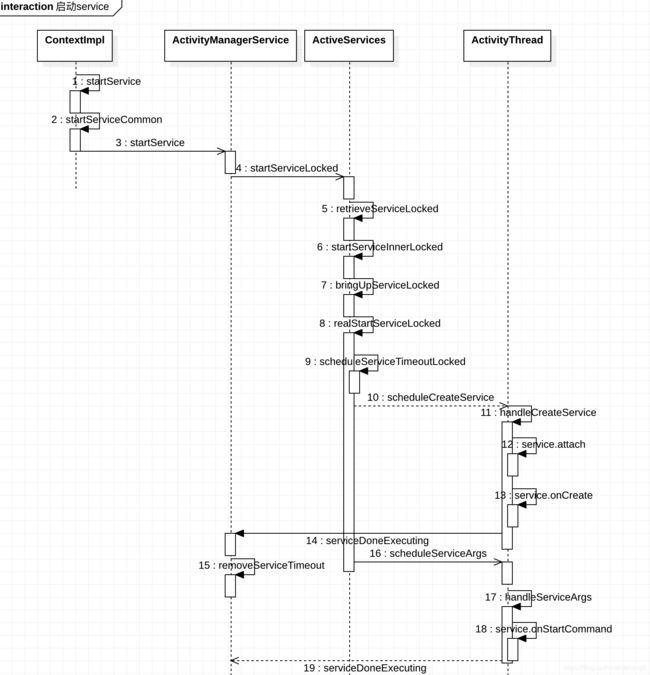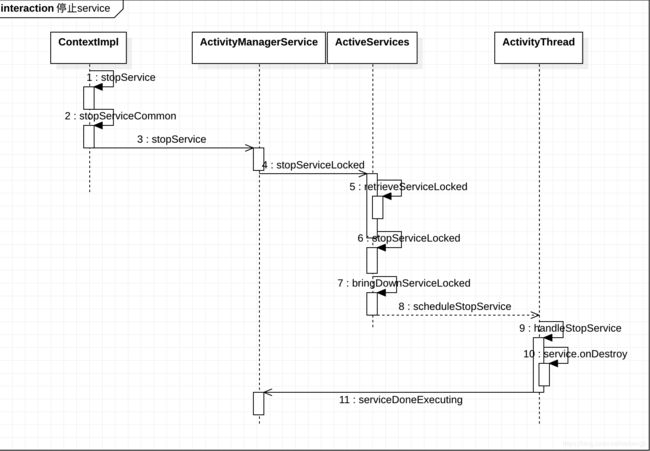Service启动流程总结-start和stop service
文章目录
- 回顾
- 概述
- 源码探究
- startService过程
- onCreate阶段
- onStartCommand阶段
- Service超时机制
- 设置超时
- 移除超时
- 触发超时
- 当目标Service进程未启动时
- stopService过程
- 总结
回顾
Activity启动系列总结:
Activity启动流程总结-ActivityThread
Activity启动流程总结-生命周期
Activity启动流程总结-超时判定机制
在Activity启动流程中对APP进程和ActivityManagerService的交互过程以及应用进程启动初始化过程做了简单总结。Service作为四大组件之一,它的启动过程大体相似。
概述
在开发中我们使用context.startService(intent)和context.stopService(intent)来启动和停止Service,Service的启动和停止也是由ActivityManagerService来进行调度,本文通过跟踪源码来看看它的启动和停止过程。
源码探究
文中源码基于 Android 10.0
startService过程
当执行context.startService(intent),将开始Service的启动过程:
[ContextImpl#startService]
public ComponentName startService(Intent service) {
warnIfCallingFromSystemProcess();
return startServiceCommon(service, false, mUser);
}
public ComponentName startForegroundService(Intent service) {
warnIfCallingFromSystemProcess();
return startServiceCommon(service, true, mUser);
}
private ComponentName startServiceCommon(Intent service, boolean requireForeground,
UserHandle user) {
try {
// ···
// 请求AMS启动Service
ComponentName cn = ActivityManager.getService().startService(
mMainThread.getApplicationThread(), service, service.resolveTypeIfNeeded(
getContentResolver()), requireForeground,
getOpPackageName(), user.getIdentifier());
if (cn != null) {
// 省略检查异常部分 ···
}
return cn;
} catch (RemoteException e) {
throw e.rethrowFromSystemServer();
}
}
可以看到通过IActivityManager调用ActivityManagerService进行startService。
接下来从APP进程来到ActivityManagerService:
[ActivityManagerService#startService]
public ComponentName startService(IApplicationThread caller, Intent service,
String resolvedType, boolean requireForeground, String callingPackage, int userId)
throws TransactionTooLargeException {
enforceNotIsolatedCaller("startService");
// Refuse possible leaked file descriptors
// 省略参数异常检查 ···
synchronized(this) {
final int callingPid = Binder.getCallingPid();
final int callingUid = Binder.getCallingUid();
final long origId = Binder.clearCallingIdentity();
ComponentName res;
try {
// mServices实例是ActiveServices
res = mServices.startServiceLocked(caller, service,
resolvedType, callingPid, callingUid,
requireForeground, callingPackage, userId);
} finally {
Binder.restoreCallingIdentity(origId);
}
return res;
}
}
该方法中调用ActiveServices的startServiceLocked方法进一步处理。
ActiveServices的startServiceLocked方法中又调用了另一个重载方法:
[ActiveServices#startServiceLocked]
ComponentName startServiceLocked(IApplicationThread caller, Intent service, String resolvedType,
int callingPid, int callingUid, boolean fgRequired, String callingPackage,
final int userId, boolean allowBackgroundActivityStarts)
throws TransactionTooLargeException {
// 省略变量callerFg部分(用于标记调用方进程是否属于前台)···
// 查找或新建可用ServiceRecord
ServiceLookupResult res =
retrieveServiceLocked(service, null, resolvedType, callingPackage,
callingPid, callingUid, userId, true, callerFg, false, false);
// 省略对res结果检查部分 ···
ServiceRecord r = res.record;
// 省略后台启动检查和启动权限检查部分 ···
// 创建startCommand参数添加到pendingStarts集合中保存
r.pendingStarts.add(new ServiceRecord.StartItem(r, false, r.makeNextStartId(),
service, neededGrants, callingUid));
// 调用startServiceInnerLocked进一步处理
ComponentName cmp = startServiceInnerLocked(smap, service, r, callerFg, addToStarting);
return cmp;
这里获取一个ServiceRecord(被包装在ServiceLookupResult中),ServiceRecord用于保存Service信息,一个ServiceRecord对应一个运行Service。然后调用startServiceInnerLocked方法进一步执行启动流程。
retrieveServiceLocked方法中,首先获取userId对应的ServiceMap缓存集合,根据ComponentName(显式意图)或IntentFilter(隐式意图)查找ServiceRecord。不存在的话,则从PackageManagerService查找匹配的ServiceInfo,之后创建ServiceRecord并保存在集合中。在返回结果前还会判断是否允许不同应用和不同userId间的调用和启动权限检查。
接下来进入startServiceInnerLocked方法:
[ActiveServices#startServiceInnerLocked]
ComponentName startServiceInnerLocked(ServiceMap smap, Intent service, ServiceRecord r,
boolean callerFg, boolean addToStarting) throws TransactionTooLargeException {
// ···
// 进一步执行启动
String error = bringUpServiceLocked(r, service.getFlags(), callerFg, false, false);
if (error != null) {
return new ComponentName("!!", error);
}
// 省略添加后台启动服务集合和启动前台服务判断部分 ···
return r.name;
}
进入bringUpServiceLocked方法:
[ActiveServices#bringUpServiceLocked]
private String bringUpServiceLocked(ServiceRecord r, int intentFlags, boolean execInFg,
boolean whileRestarting, boolean permissionsReviewRequired)
throws TransactionTooLargeException {
// 判断目标Service是否已启动,首次将要启动时ServiceRecord中还未设置IApplicationThread
if (r.app != null && r.app.thread != null) {
// 调度应用进程触发onStartCommand回调
sendServiceArgsLocked(r, execInFg, false);
return null;
}
// 判断目标Service是否等待重启
if (!whileRestarting && mRestartingServices.contains(r)) {
// If waiting for a restart, then do nothing.
return null;
}
// ···
// 重置目标Service的延迟启动标识 ···
// 检查目标Service的userId对应用户是否已启动 ···
// ···
final boolean isolated = (r.serviceInfo.flags&ServiceInfo.FLAG_ISOLATED_PROCESS) != 0;
final String procName = r.processName;
HostingRecord hostingRecord = new HostingRecord("service", r.instanceName);
ProcessRecord app;
if (!isolated) {
// 查找对应进程的ProcessRecord
app = mAm.getProcessRecordLocked(procName, r.appInfo.uid, false);
if (DEBUG_MU) Slog.v(TAG_MU, "bringUpServiceLocked: appInfo.uid=" + r.appInfo.uid
+ " app=" + app);
// 通过ProcessRecord的的IApplicationThread判断进程是否启动
if (app != null && app.thread != null) {
try {
app.addPackage(r.appInfo.packageName, r.appInfo.longVersionCode, mAm.mProcessStats);
// 进一步执行启动
realStartServiceLocked(r, app, execInFg);
return null;
} catch (TransactionTooLargeException e) {
throw e;
} catch (RemoteException e) {
Slog.w(TAG, "Exception when starting service " + r.shortInstanceName, e);
}
// If a dead object exception was thrown -- fall through to
// restart the application.
}
} else {
// 省略ISOLATED PROCESS SERVICE部分 ···
}
// Not running -- get it started, and enqueue this service record
// to be executed when the app comes up.
if (app == null && !permissionsReviewRequired) {
// 省略启动进程部分,会调用mAm.startProcessLocked方法 ···
}
// ···
// 将ServiceRecord添加至待启动集合缓存,等待进场启动后再执行启动流程
if (!mPendingServices.contains(r)) {
mPendingServices.add(r);
}
// 省略延迟启动但是Service又被要求停止,会调用stopServiceLocked方法 ···
return null;
}
该方法中首先判断目标Service是否已启动,如果已经启动则会调度onStartCommand回调。接着判断目标Service所属进程是否启动,如果已经启动则进一步执行Service启动流程,否则将ServiceRecord添加到待启动集合,等待目标进程启动完成后再执行启动流程。
PS:这里通过ProcessRecord是否持有IApplicationThread来判断目标Service和目标进程是否启动。当目标Service启动后,会为对应ServiceRecord设置ProcessRecord和IApplicationThread。当目标进程启动后,会为对应ProcessRecord设置IApplicationThread。可参考《Activity启动流程总结-ActivityThread》。
接下来进入关键方法realStartServiceLocked:
[ActiveServices#realStartServiceLocked]
private final void realStartServiceLocked(ServiceRecord r,
ProcessRecord app, boolean execInFg) throws RemoteException {
// ···
// 这里给ServiceRecord设置了ProcessRecord,便可通过ServiceRecord判断目标Service是否已启动
r.setProcess(app);
// ···
// ProcessRecord的services集合保存对应进程中所有运行的Service信息
final boolean newService = app.services.add(r);
// 超时设置相关
bumpServiceExecutingLocked(r, execInFg, "create");
// ···
boolean created = false;
try {
// 调度应用进程启动Service
app.thread.scheduleCreateService(r, r.serviceInfo,
mAm.compatibilityInfoForPackage(r.serviceInfo.applicationInfo),
app.getReportedProcState());
// 前台Service前台通知相关
r.postNotification();
created = true;
} catch (DeadObjectException e) {
Slog.w(TAG, "Application dead when creating service " + r);
mAm.appDiedLocked(app);
throw e;
} finally {
if (!created) {
// 省略Service启动失败异常处理部分 ···
}
}
// ···
// 省略bind Service相关流程部分 ···
// ···
// 发送参数到应用进程,将触发onStartCommand回调
sendServiceArgsLocked(r, execInFg, true);
// ···
}
这里会先后两次调度应用进程,应用侧会先后往应用主进程消息队列添加两条任务消息,AMS侧继续往下执行它的其余逻辑,下面需要到应用侧看创建Service的过程。
在看create Service流程前,先看看sendServiceArgsLocked方法:
[ActiveServices#sendServiceArgsLocked]
private final void sendServiceArgsLocked(ServiceRecord r, boolean execInFg,
boolean oomAdjusted) throws TransactionTooLargeException {
// pendingStarts保存待派发执行startCommand的命令参数
final int N = r.pendingStarts.size();
if (N == 0) {
return;
}
ArrayList<ServiceStartArgs> args = new ArrayList<>();
while (r.pendingStarts.size() > 0) {
// 封装参数保存在args中 ···
}
// ParceledListSlice用于跨IPC传输大量Parcelable对象,可拆分为多个binder_transact事务传输。
ParceledListSlice<ServiceStartArgs> slice = new ParceledListSlice<>(args);
slice.setInlineCountLimit(4);
Exception caughtException = null;
try {
// 调度应用进程执行onStartCommand回调
r.app.thread.scheduleServiceArgs(r, slice);
} catch (TransactionTooLargeException e) {
if (DEBUG_SERVICE) Slog.v(TAG_SERVICE, "Transaction too large for " + args.size()
+ " args, first: " + args.get(0).args);
Slog.w(TAG, "Failed delivering service starts", e);
caughtException = e;
} catch (RemoteException e) {
// Remote process gone... we'll let the normal cleanup take care of this.
if (DEBUG_SERVICE) Slog.v(TAG_SERVICE, "Crashed while sending args: " + r);
Slog.w(TAG, "Failed delivering service starts", e);
caughtException = e;
} catch (Exception e) {
Slog.w(TAG, "Unexpected exception", e);
caughtException = e;
}
if (caughtException != null) {
// Keep nesting count correct
// 省略异常处理部分 ···
}
}
该方法中进行封装批量StartCommand参数,然后调度应用进程执行scheduleServiceArgs方法。
接下来在应用侧将会先后执行Service的create和start两个消息任务。
onCreate阶段
app.thread.scheduleCreateService将执行应用进程ActivityThread的scheduleCreateService方法,该方法中会发生H.CREATE_SERVICE消息至主线程,将执行handleCreateService方法。
[ActivityThread#handleCreateService]
private void handleCreateService(CreateServiceData data) {
// If we are getting ready to gc after going to the background, well
// we are back active so skip it.
// 移除请求GC的消息
unscheduleGcIdler();
LoadedApk packageInfo = getPackageInfoNoCheck(
data.info.applicationInfo, data.compatInfo);
Service service = null;
try {
// 通过反射实例化目标Service
java.lang.ClassLoader cl = packageInfo.getClassLoader();
service = packageInfo.getAppFactory()
.instantiateService(cl, data.info.name, data.intent);
} catch (Exception e) {
// 省略异常处理 ···
}
try {
if (localLOGV) Slog.v(TAG, "Creating service " + data.info.name);
// 创建上下文ContextImpl
ContextImpl context = ContextImpl.createAppContext(this, packageInfo);
// context持有service实例
context.setOuterContext(service);
// 获取应用进程Application实例
Application app = packageInfo.makeApplication(false, mInstrumentation);
// service中保存传入的参数,会调用attachBaseContext方法使mBase持有ContextImpl
service.attach(context, this, data.info.name, data.token, app,
ActivityManager.getService());
// 调用Service的onCreate生命周期回调方法
service.onCreate();
// 以token为key,添加service实例至集合缓存(token是AMS传来的ServiceRecord客户端代理,ServiceRecord继承自Binder)
mServices.put(data.token, service);
try {
// 通知AMS创建完成
ActivityManager.getService().serviceDoneExecuting(
data.token, SERVICE_DONE_EXECUTING_ANON, 0, 0);
} catch (RemoteException e) {
throw e.rethrowFromSystemServer();
}
} catch (Exception e) {
// 省略异常处理 ···
}
}
首先通过反射创建目标Service,之后创建ContextImpl并使ContextImpl和Service互相持有对方引用,获取应用Application实例并使Service持有其引用。接着便调用onCreate生命周期回调方法。最后再通知AMS创建完成。
再来到ActivityManagerService,在它的serviceDoneExecuting方法中又调用了ActiveServices的serviceDoneExecutingLocked方法:
[ActiveServices#serviceDoneExecutingLocked]
void serviceDoneExecutingLocked(ServiceRecord r, int type, int startId, int res) {
// mDestroyingServices保存执行销毁的Service
boolean inDestroying = mDestroyingServices.contains(r);
if (r != null) {
// 判断type类型。
// 刚create时是SERVICE_DONE_EXECUTING_ANON,startCommand时是SERVICE_DONE_EXECUTING_START,stop时是SERVICE_DONE_EXECUTING_STOP。
if (type == ActivityThread.SERVICE_DONE_EXECUTING_START) {
// 设置ServiceRecord相关参数,主要设置stopIfKilled(异常杀死是否不能够重启) ···
} else if (type == ActivityThread.SERVICE_DONE_EXECUTING_STOP) {
// ···
}
final long origId = Binder.clearCallingIdentity();
// 更新ServiceRecord中的状态,移除超时消息
serviceDoneExecutingLocked(r, inDestroying, inDestroying);
Binder.restoreCallingIdentity(origId);
} else {
Slog.w(TAG, "Done executing unknown service from pid "
+ Binder.getCallingPid());
}
该方法主要是处理ServiceRecord中的参数和状态更新设置,以及移除超时消息。
onStartCommand阶段
app.thread.scheduleServiceArgs将会执行ActivityThread的scheduleServiceArgs方法:
[ActivityThread#scheduleServiceArgs]
public final void scheduleServiceArgs(IBinder token, ParceledListSlice args) {
List<ServiceStartArgs> list = args.getList();
for (int i = 0; i < list.size(); i++) {
// 依次取出参数,发送到主线程执行
ServiceStartArgs ssa = list.get(i);
ServiceArgsData s = new ServiceArgsData();
s.token = token;
s.taskRemoved = ssa.taskRemoved;
s.startId = ssa.startId;
s.flags = ssa.flags;
s.args = ssa.args;
sendMessage(H.SERVICE_ARGS, s);
}
}
H.SERVICE_ARGS消息将会执行handleServiceArgs方法:
[ActivityThread#handleServiceArgs]
private void handleServiceArgs(ServiceArgsData data) {
// 取出create阶段创建并缓存的Service实例
Service s = mServices.get(data.token);
if (s != null) {
try {
if (data.args != null) {
// 给Intent设置ClassLoader
data.args.setExtrasClassLoader(s.getClassLoader());
data.args.prepareToEnterProcess();
}
int res;
if (!data.taskRemoved) {
// 触发Service的onStartCommand生命周期回调
res = s.onStartCommand(data.args, data.flags, data.startId);
} else {
s.onTaskRemoved(data.args);
res = Service.START_TASK_REMOVED_COMPLETE;
}
// 这里会阻塞当前线程,直到QueuedWork中的Runnable执行完毕。(SharedPreference会用到)
QueuedWork.waitToFinish();
try {
// 通知AMS执行完成
ActivityManager.getService().serviceDoneExecuting(
data.token, SERVICE_DONE_EXECUTING_START, data.startId, res);
} catch (RemoteException e) {
throw e.rethrowFromSystemServer();
}
} catch (Exception e) {
if (!mInstrumentation.onException(s, e)) {
throw new RuntimeException(
"Unable to start service " + s
+ " with " + data.args + ": " + e.toString(), e);
}
}
}
}
这里取出缓存的Service实例,然后便调用其onStartCommand生命周期回调方法。最后也会通知AMS进行状态更新操作。
到这里,Service的启动流程便完成,先后经过了onCreate和onStartCommand生命周期回调。
Service超时机制
在Service启动过程中,AMS会进行超时机制相关设置,包括设置超时时间、触发超时处理、移除超时处理。
设置超时
回到ActiveServices#realStartServiceLocked方法中,在调度应用进程创建Service前,会先执行bumpServiceExecutingLocked方法,在该方法中会调用scheduleServiceTimeoutLocked方法进行超时监听的设置。
[ActiveServices#scheduleServiceTimeoutLocked]
void scheduleServiceTimeoutLocked(ProcessRecord proc) {
if (proc.executingServices.size() == 0 || proc.thread == null) {
return;
}
// 获取SERVICE_TIMEOUT_MSG消息
Message msg = mAm.mHandler.obtainMessage(
ActivityManagerService.SERVICE_TIMEOUT_MSG);
msg.obj = proc;
// 发送延迟消息
mAm.mHandler.sendMessageDelayed(msg,
proc.execServicesFg ? SERVICE_TIMEOUT : SERVICE_BACKGROUND_TIMEOUT);
}
该方法中发送一个延迟消息SERVICE_TIMEOUT_MSG,当20s(启动前台服务)或200s(启动后台服务)后仍没有执行完,则会触发超时处理。
移除超时
当应用进程侧完成Service启动后,便会调用AMS侧的ActiveServices#serviceDoneExecutingLocked方法,其中会进行超时消息的移除:
[ActiveServices#serviceDoneExecutingLocked]
private void serviceDoneExecutingLocked(ServiceRecord r, boolean inDestroying,
boolean finishing) {
// ···
// 移除SERVICE_TIMEOUT_MSG消息
mAm.mHandler.removeMessages(ActivityManagerService.SERVICE_TIMEOUT_MSG, r.app);
// ···
}
触发超时
若在规定时间内,应用侧没有及时完成启动流程和通知AMS,则会触发超时逻辑,将会执行ActiveServices的serviceTimeout方法。
[ActiveServices#serviceTimeout]
void serviceTimeout(ProcessRecord proc) {
// ···
if (anrMessage != null) {
// dump ANR信息和触发ANR弹窗
proc.appNotResponding(null, null, null, null, false, anrMessage);
}
}
当触发超时后,将会触发ANR。
当目标Service进程未启动时
在前面的ActiveServices#bringUpServiceLocked方法中,会首先判断若目标Service进程尚未已经启动,则会先启动应用进程,然后将ServiceRecord保存在mPendingServices集合中。
当应用进程启动后,会调用ActivityManagerService的attachApplicationLocked方法,在该方法中会执行待启动的Service。
[ActivityManagerService#attachApplicationLocked]
private final boolean attachApplicationLocked(IApplicationThread thread,
int pid, int callingUid, long startSeq) {
// ···
// thread.bindApplication
// ···
// Find any services that should be running in this process...
if (!badApp) {
try {
// 启动等待对应进程启动的Service
didSomething |= mServices.attachApplicationLocked(app, processName);
checkTime(startTime, "attachApplicationLocked: after mServices.attachApplicationLocked");
} catch (Exception e) {
Slog.wtf(TAG, "Exception thrown starting services in " + app, e);
badApp = true;
}
}
// ···
}
调用了ActiveServices的attachApplicationLocked方法:
[ActiveServices#attachApplicationLocked]
boolean attachApplicationLocked(ProcessRecord proc, String processName)
throws RemoteException {
boolean didSomething = false;
// Collect any services that are waiting for this process to come up.
if (mPendingServices.size() > 0) {
ServiceRecord sr = null;
try {
// 遍历待启动ServiceRecord
for (int i=0; i<mPendingServices.size(); i++) {
sr = mPendingServices.get(i);
if (proc != sr.isolatedProc && (proc.uid != sr.appInfo.uid
|| !processName.equals(sr.processName))) {
continue;
}
mPendingServices.remove(i);
i--;
proc.addPackage(sr.appInfo.packageName, sr.appInfo.longVersionCode,
mAm.mProcessStats);
// 执行realStartServiceLocked进行启动流程
realStartServiceLocked(sr, proc, sr.createdFromFg);
didSomething = true;
if (!isServiceNeededLocked(sr, false, false)) {
// We were waiting for this service to start, but it is actually no
// longer needed. This could happen because bringDownServiceIfNeeded
// won't bring down a service that is pending... so now the pending
// is done, so let's drop it.
bringDownServiceLocked(sr);
}
}
} catch (RemoteException e) {
Slog.w(TAG, "Exception in new application when starting service "
+ sr.shortInstanceName, e);
throw e;
}
}
// Also, if there are any services that are waiting to restart and
// would run in this process, now is a good time to start them. It would
// be weird to bring up the process but arbitrarily not let the services
// run at this point just because their restart time hasn't come up.
if (mRestartingServices.size() > 0) {
// 省略待重启Service部分 ···
}
return didSomething;
}
可以看到,当应用进程启动完成通知AMS后,会再进行Service启动流程。
stopService过程
停止Service通过调用context.stopService方法:
[ContextImpl#stopService]
public boolean stopService(Intent service) {
warnIfCallingFromSystemProcess();
return stopServiceCommon(service, mUser);
}
private boolean stopServiceCommon(Intent service, UserHandle user) {
try {
// ···
// 请求AMS执行stopService调度
int res = ActivityManager.getService().stopService(
mMainThread.getApplicationThread(), service,
service.resolveTypeIfNeeded(getContentResolver()), user.getIdentifier());
// ···
} catch (RemoteException e) {
throw e.rethrowFromSystemServer();
}
}
和startService一样,也是调用ActivityManagerService的方法,在stopService中又会调用ActiveServices的stopServiceLocked方法:
[ActiveServices#stopServiceLocked]
int stopServiceLocked(IApplicationThread caller, Intent service,
String resolvedType, int userId) {
// ···
// If this service is active, make sure it is stopped.
ServiceLookupResult r = retrieveServiceLocked(service, null, resolvedType, null,
Binder.getCallingPid(), Binder.getCallingUid(), userId, false, false, false, false);
if (r != null) {
if (r.record != null) {
final long origId = Binder.clearCallingIdentity();
try {
stopServiceLocked(r.record);
} finally {
Binder.restoreCallingIdentity(origId);
}
return 1;
}
return -1;
}
return 0;
}
首先查找目标ServiceRecord,然后调用stopServiceLocked方法。
stopServiceLocked方法最终会调用bringDownServiceLocked方法:
[ActiveServices#bringDownServiceLocked]
private final void bringDownServiceLocked(ServiceRecord r) {
// ···
if (r.app != null) {
if (r.app.thread != null) {
try {
// ···
r.app.thread.scheduleStopService(r);
} catch (Exception e) {
// ···
}
} else {
// ···
}
} else {
// ···
}
// ···
}
调度应用进程执行stop操作。
scheduleStopService将发送H.STOP_SERVICE消息,最终将执行handleStopService方法:
[ActivityThread#handleStopService]
private void handleStopService(IBinder token) {
// 获取缓存的Service实例
Service s = mServices.remove(token);
if (s != null) {
try {
if (localLOGV) Slog.v(TAG, "Destroying service " + s);
// 执行onDestroy回调
s.onDestroy();
s.detachAndCleanUp();
Context context = s.getBaseContext();
if (context instanceof ContextImpl) {
final String who = s.getClassName();
((ContextImpl) context).scheduleFinalCleanup(who, "Service");
}
QueuedWork.waitToFinish();
try {
// 通知AMS
ActivityManager.getService().serviceDoneExecuting(
token, SERVICE_DONE_EXECUTING_STOP, 0, 0);
} catch (RemoteException e) {
throw e.rethrowFromSystemServer();
}
} catch (Exception e) {
// ···
}
} else {
Slog.i(TAG, "handleStopService: token=" + token + " not found.");
}
//Slog.i(TAG, "Running services: " + mServices);
}
应用侧stopService就是从mServices集合中移除Service实例,并执行它的onDestroy生命周期回调方法,最后通知AMS。
总结
Service的启动和停止都是通过发请求给ActivityManagerService,由AMS来进行调度分发。AMS侧通过ServiceRecord记录运行Service的信息,应用侧通过mServices集合保存反射创建的Service实例。AMS发送启动或停止指令到应用侧后,由应用侧对Service实例执行对应的生命周期回调。
下面用时序图总结这两个流程。
启动流程:
停止流程:

